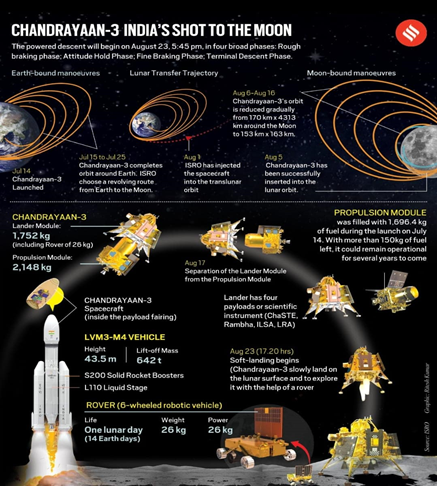

24th August 2023 (9 Topics)
Context
After rolling down of Chandrayaan-3’s lander will begin its job of lunar exploration and will start collecting information operating for a single lunar day or equivalent 14 Earth days.
The Historic Landing:
- Chandrayaan-3 has landed around 70 degree south latitude, the closest that any spacecraft has reached to the lunar South Pole.
- The Chandrayaan-3 spacecraft consists of three parts:
- Lander: The lander will be powered by four throttle-able engines and will feature a Laser Doppler Velocimeter (LDV).
- Rover: The rover will carry out chemical analysis of the lunar surface. Both the lander and the rover carry many scientific payloads for experiments on the lunar surface.
- Propulsion module: The propulsion module has one main function—to carry the lander and rover from “launch vehicle injection” to a 100-kilometre circular polar lunar orbit before it separates from the other modules.

Mission experiments:
- Experiments by the Lander: The lander has four experiments on board:
- The Radio Anatomy of Moon Bound Hypersensitive ionosphere and Atmosphere (RAMBHA) will study the electrons and ions near the surface of the moon and how they change over time.
- The Chandra’s Surface Thermo physical Experiment (ChaSTE) will study the thermal properties of the lunar surface near the polar region.
- The Instrument for Lunar Seismic Activity (ILSA) will measure the lunar quakes near the landing site and study the composition of the Moon’s crust and mantle.
- The LASER Retroreflector Array (LRA) is a passive experiment sent by NASA that acts as a target for lasers for very accurate measurements for future missions.
- Experiments by Rover: There are two scientific experiments on the rover:
- The LASER Induced Breakdown Spectroscope (LIBS) will determine the chemical and mineral composition of the lunar surface.
- The Alpha Particle X-ray Spectrometer (APXS) will determine the composition of elements such as magnesium, aluminium, silicon, potassium, calcium, titanium, and iron in the lunar soil and rocks.
Expected outcomes:
- Discovery of water:
- The southern polar region of the Moon is known to have deep craters that remain in permanent darkness, with a high likelihood of having water-ice.
- India’s Moon Impact Probe (MIP) — a payload that was deliberately crashed on the lunar surface near the South Pole — helped study the concentration of water and hydroxyl molecules in the lunar atmosphere in Chandrayaan-1 mission.
- Buried lava tubes:
- The terrain mapping camera and hyper-spectral imager on board Chandrayaan-1 detected an underground lava tube, which, scientists believe, can provide a safe environment for human habitation in the future.
- It can protect against hazardous radiation, small meteoric impacts, extreme temperatures, and dust storms on the surface of the Moon.
- Magma ocean thesis:
- The Moon is believed to have been formed after an early piece of the Earth separated due to an impact.
- The energy generated by the impact is believed to have led to the melting of the Moon’s surface. This is called the magma ocean hypothesis.
- The M3 payload on board Chandrayaan-1 picked up a specific type of lighter-density crystals on the surface of the Moon, which could be found on the surface only if it were liquid once.
- Solar flares:
- The Solar X-Ray Monitor on the Chandrayaan-2 orbiter was able to observe many solar microflares outside the active region as well as the elemental abundance from the not-so-bright solar corona.
- Mapping of minerals:
-
- CLASS X-ray Fluorescence experiment has mapped about 95% of the lunar surface in X-rays for the first time.
More Articles


